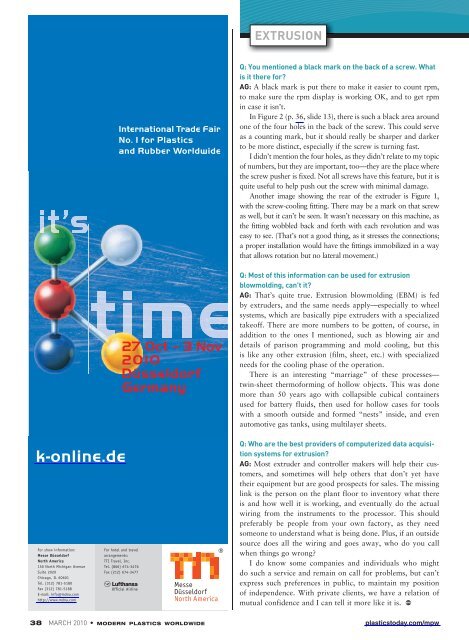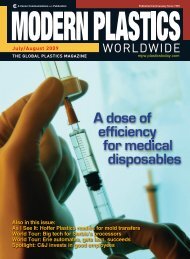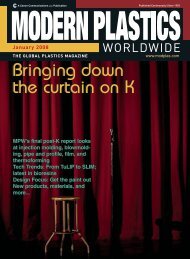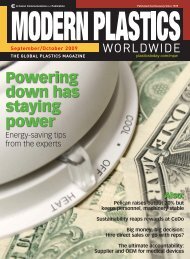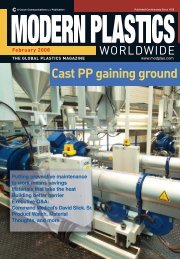Modern Plastics Worldwide - March 2010 - dae uptlax
Modern Plastics Worldwide - March 2010 - dae uptlax
Modern Plastics Worldwide - March 2010 - dae uptlax
Create successful ePaper yourself
Turn your PDF publications into a flip-book with our unique Google optimized e-Paper software.
k-online.de<br />
For show information:<br />
Messe Düsseldorf<br />
North America<br />
150 North Michigan Avenue<br />
Suite 2920<br />
Chicago, IL 60601<br />
Tel. (312) 781-5180<br />
Fax (312) 781-5188<br />
E-mail: info@mdna.com<br />
http://www.mdna.com<br />
International Trade Fair<br />
No. 1 for <strong>Plastics</strong><br />
and Rubber <strong>Worldwide</strong><br />
For hotel and travel<br />
arrangements:<br />
TTI Travel, Inc.<br />
Tel. (866) 674-3476<br />
Fax (212) 674-3477<br />
Official Airline<br />
EXTRUSION<br />
Q: You mentioned a black mark on the back of a screw. What<br />
is it there for?<br />
AG: A black mark is put there to make it easier to count rpm,<br />
to make sure the rpm display is working OK, and to get rpm<br />
in case it isn’t.<br />
In Figure 2 (p. 36, slide 13), there is such a black area around<br />
one of the four holes in the back of the screw. This could serve<br />
as a counting mark, but it should really be sharper and darker<br />
to be more distinct, especially if the screw is turning fast.<br />
I didn’t mention the four holes, as they didn’t relate to my topic<br />
of numbers, but they are important, too—they are the place where<br />
the screw pusher is fixed. Not all screws have this feature, but it is<br />
quite useful to help push out the screw with minimal damage.<br />
Another image showing the rear of the extruder is Figure 1,<br />
with the screw-cooling fitting. There may be a mark on that screw<br />
as well, but it can’t be seen. It wasn’t necessary on this machine, as<br />
the fitting wobbled back and forth with each revolution and was<br />
easy to see. (That’s not a good thing, as it stresses the connections;<br />
a proper installation would have the fittings immobilized in a way<br />
that allows rotation but no lateral movement.)<br />
Q: Most of this information can be used for extrusion<br />
blowmolding, can’t it?<br />
AG: That’s quite true. Extrusion blowmolding (EBM) is fed<br />
by extruders, and the same needs apply—especially to wheel<br />
systems, which are basically pipe extruders with a specialized<br />
takeoff. There are more numbers to be gotten, of course, in<br />
addition to the ones I mentioned, such as blowing air and<br />
details of parison programming and mold cooling, but this<br />
is like any other extrusion (film, sheet, etc.) with specialized<br />
needs for the cooling phase of the operation.<br />
There is an interesting “marriage” of these processes—<br />
twin-sheet thermoforming of hollow objects. This was done<br />
more than 50 years ago with collapsible cubical containers<br />
used for battery fluids, then used for hollow cases for tools<br />
with a smooth outside and formed “nests” inside, and even<br />
automotive gas tanks, using multilayer sheets.<br />
Q: Who are the best providers of computerized data acquisition<br />
systems for extrusion?<br />
AG: Most extruder and controller makers will help their customers,<br />
and sometimes will help others that don’t yet have<br />
their equipment but are good prospects for sales. The missing<br />
link is the person on the plant floor to inventory what there<br />
is and how well it is working, and eventually do the actual<br />
wiring from the instruments to the processor. This should<br />
preferably be people from your own factory, as they need<br />
someone to understand what is being done. Plus, if an outside<br />
source does all the wiring and goes away, who do you call<br />
when things go wrong?<br />
I do know some companies and individuals who might<br />
do such a service and remain on call for problems, but can’t<br />
express such preferences in public, to maintain my position<br />
of independence. With private clients, we have a relation of<br />
mutual confidence and I can tell it more like it is. MPW<br />
38 MARCH <strong>2010</strong> • MODERN PLASTICS WORLDWIDE plasticstoday.com/mpw


